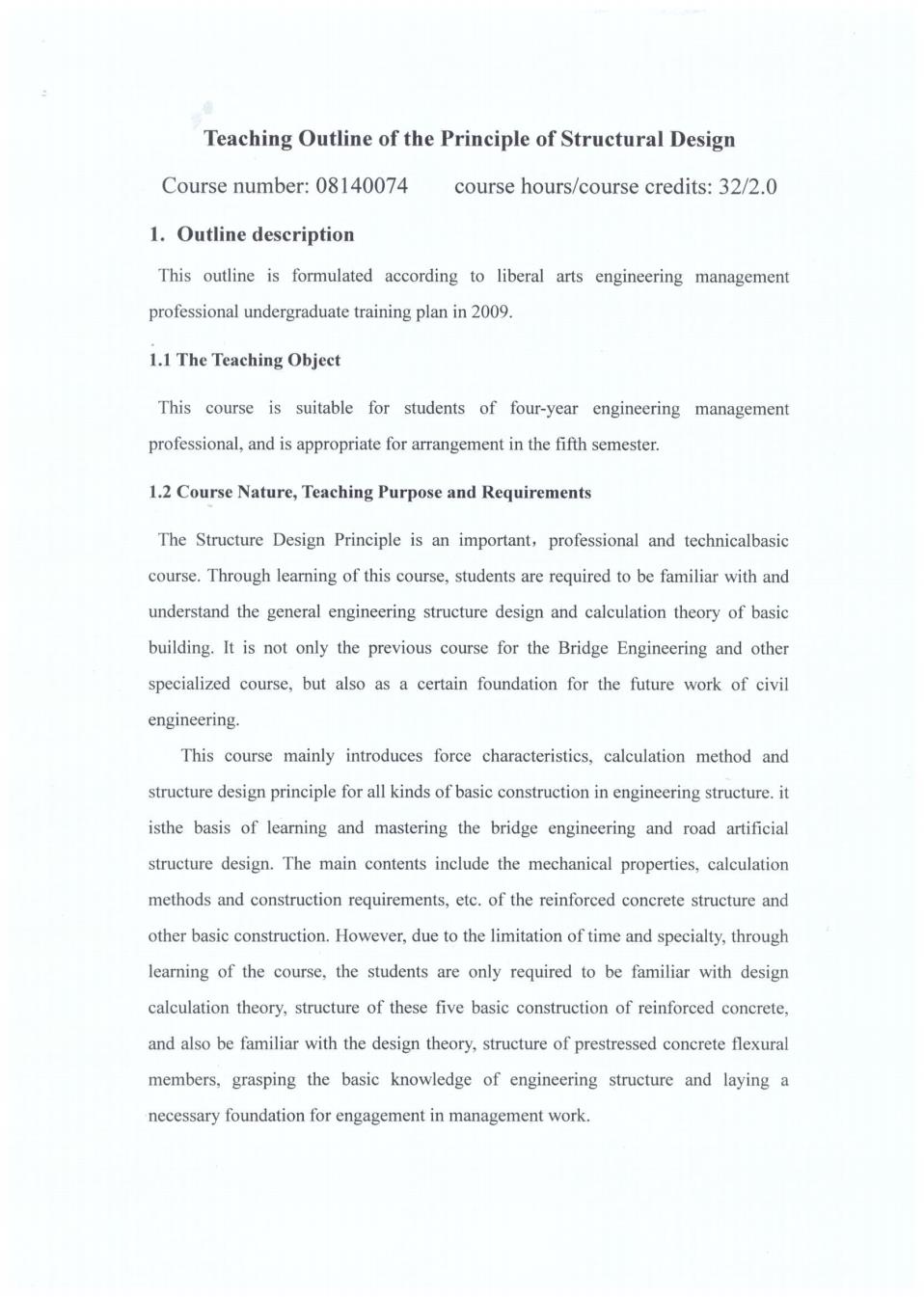
Teaching Outline of the Principle of Structural Design Course number:08140074 course hours/course credits:32/2.0 1.Outline description This outline is formulated according to liberal arts engineering management professional undergraduate training plan in2009. 1.1 The Teaching Objeet This course is suitable for students of four-year engineering management professional,and is appropriate for arrangement in the fifth semester. 1.2 Course Nature,Teaching Purpose and Requirements The Structure Design Principle is an important,professional and technicalbasic course.Through learning of this course,students are required to be familiar with and understand the general engineering structure design and calculation theory of basic building.It is not only the previous course for the Bridge Engineering and other specialized course,but also as a certain foundation for the future work of civil engineering This course mainly introduces force characteristics,calculation method and structure design principle for all kinds of basic construction in engineering structure.it isthe basis of learning and mastering the bridge engineering and road artificial structure design.The main contents include the mechanical properties,calculation methods and construction requirements,etc.of the reinforced concrete structure and other basic construction.However,due to the limitation of time and specialty,through learning of the course,the students are only required to be familiar with design calculation theory,structure of these five basic construction of reinforced concrete. and also be familiar with the design theory,structure of prestressed concrete flexural members,grasping the basic knowledge of engineering structure and laying a necessary foundation for engagement in management work
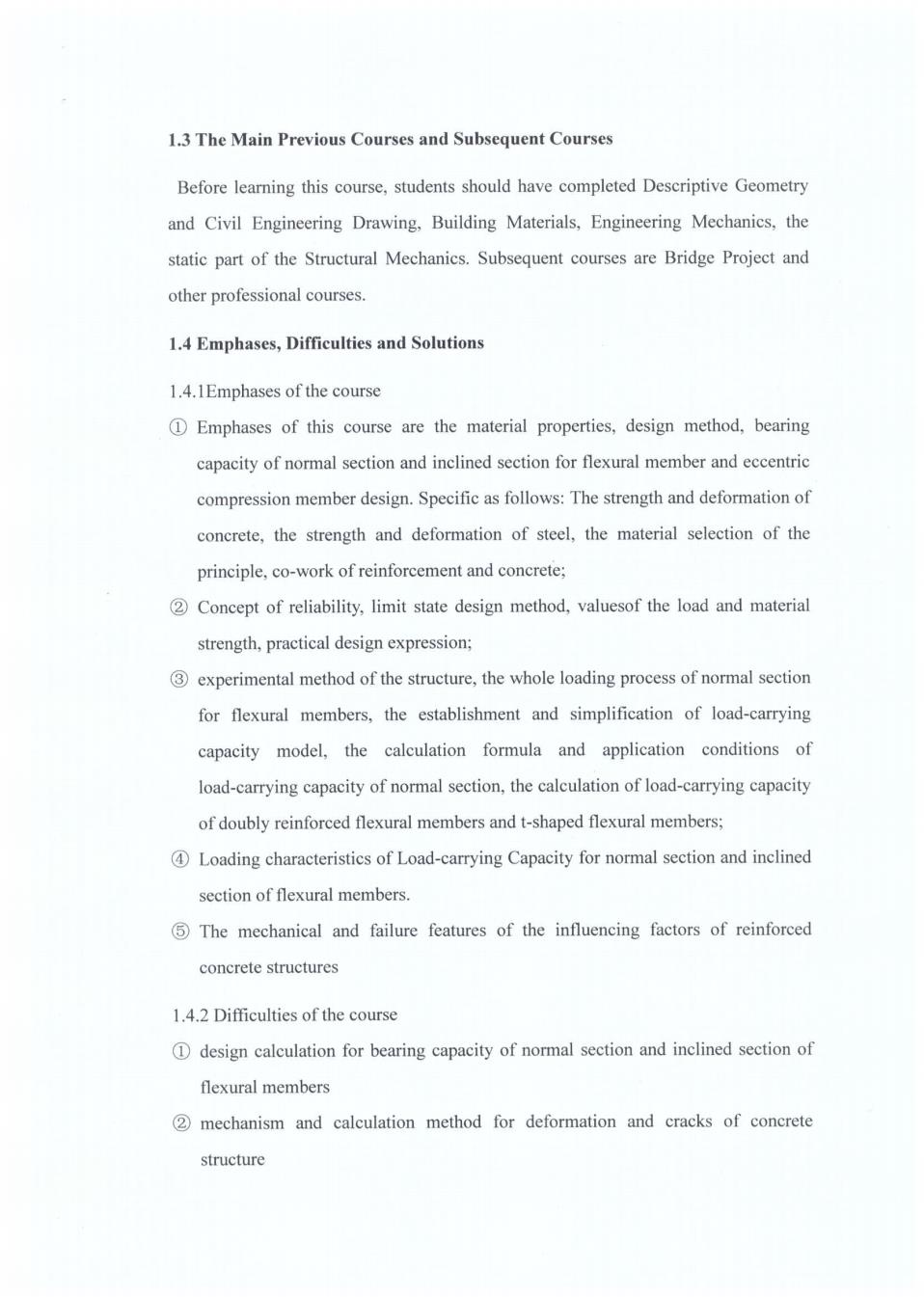
1.3 The Main Previous Courses and Subsequent Courses Before learning this course,students should have completed Descriptive Geometry and Civil Engineering Drawing,Building Materials,Engineering Mechanics,the static part of the Structural Mechanics.Subsequent courses are Bridge Project and other professional courses. 1.4 Emphases,Difficulties and Solutions 1.4.1Emphases of the course Emphases of this course are the material properties,design method,bearing capacity of normal section and inclined section for flexural member and eccentric compression member design.Specific as follows:The strength and deformation of concrete,the strength and deformation of steel,the material selection of the principle,co-work of reinforcement and concrete; 2Concept of reliability,limit state design method,valuesof the load and material strength,practical design expression 3experimental method of the structure,the whole loading process of normal section for flexural members,the establishment and simplification of load-carrying capacity model,the caleulation formula and application conditions of oad-carrying capacity of normal section,the calculation of load-carrying capacity of doubly reinforced flexural members and t-shaped flexural members; Loading characteristics of Load-carrying Capacity for normal section and inclined section of flexural members. 5The mechanical and failure features of the influencing factors of reinforced concrete structures 1.4.2 Difficulties of the course design calculation for bearing capacity of normal section and inclined section of flexural members 2 mechanism and calculation method for deformation and cracks of concrete structure

design calculation of bearing capacity of eccentric compression members concept and calculation features of prestressed concrete structures calculation principle of probability limit state design method 1.4.3 Solutions to emphases and difficulties This course can be divided into two sections as basic theory and engineering application.Due to the abstract basic theory part,the practical highlight of engineering application part,and few actual lesson,solutions to emphases and difficulties are applied in the course content and teaching as follows: 1 Preview and guidance,emphases and breakthrough For the emphases and difficulties,in order for purposive and targeted preview,some preview and guidance and pose of questions before explaining the course are necessary.Teaching of emphases and difficulties should be appropriately slowed down,and also the review questions are necessary.After class,students are mainly required to make the summary and conclusion in the review.In order to help students to eamn,summary,emphases,conclusion,key and difficult points of each chapter and common questions should be concluded in each chapter notes. 2Making full use of the network teaching resources,carrying out the traditional and multimedia teaching Combination method of the traditional chalk and writing with self-made PPT course are used for classroom teaching.As for the outline content and time-consuming rendering graphics,they should be previously made through courseware,and for the formula part that must be mastered,it is still be taught through traditional teaching methods.If students encounter some problems or miss notes in class,they can review PPT and online courses for further study. Using multiple teaching methods to improve students'self-study ability To emphasize the teaching of heuristic and discussion and strengthen the interaction between teachers and students,to construct the independent teaching mode of "Teacher is Guidance,Student is the Main Body and Ability Training is the Main Line"to improve the students'self-study ability
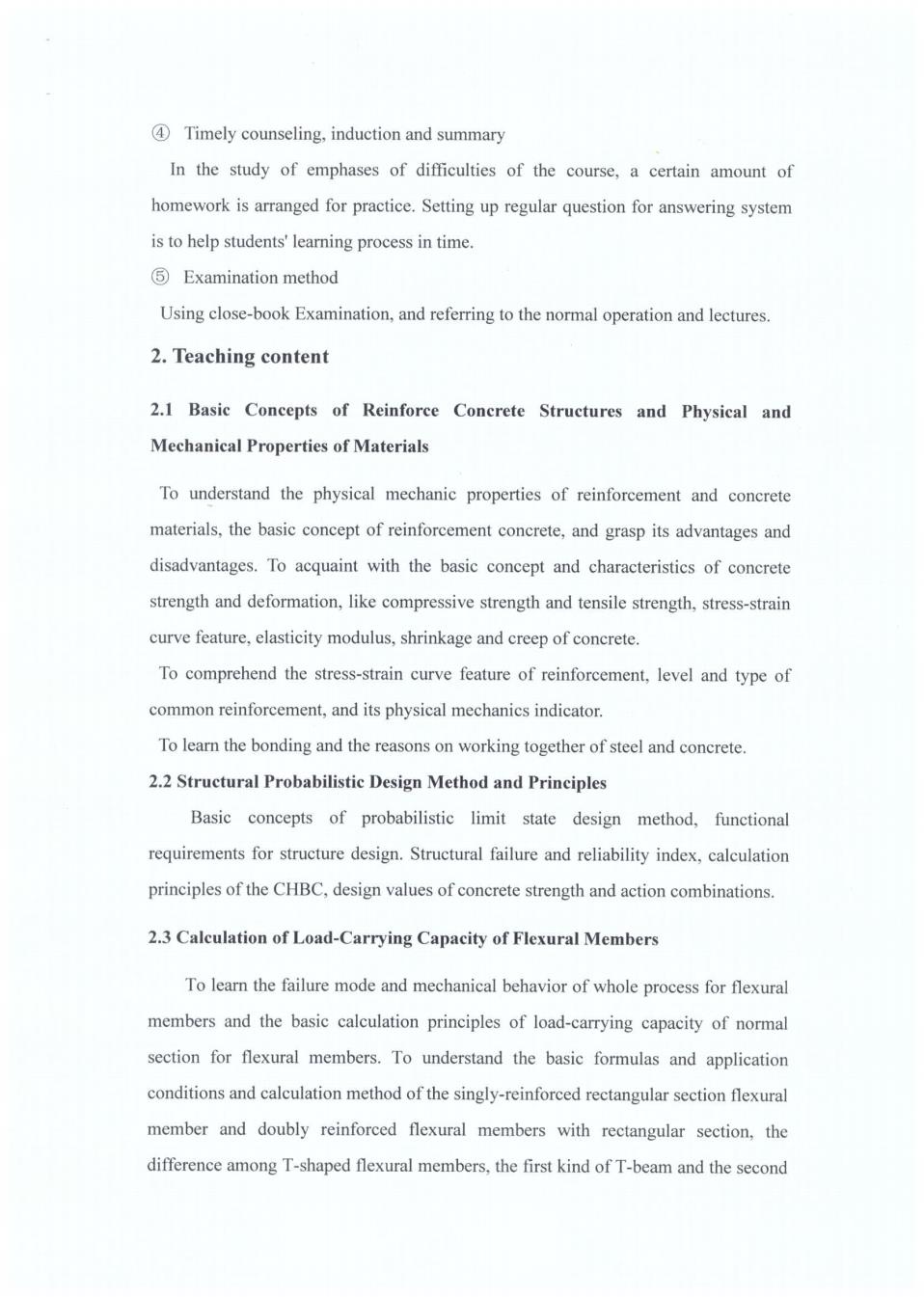
4Timely counseling.induction and summary In the study of emphases of difficulties of the course,a certain amount of homework is arranged for practice.Setting up regular question for answering system is to help students'learning process in time. ⑤Examination method Using elose-book Examination,and referring to the normal operation and lectures. 2.Teaching content 2.1 Basic Concepts of Reinforce Conerete Struetures and Physical and Mechanical Properties of Materials To understand the physical mechanic properties of reinforcement and concrete materials,the basic concept of reinforcement concrete,and grasp its advantages and disadvantages.To acquaint with the basic concept and characteristics of concrete strength and deformation,like compressive strength and tensile strength,stress-strain curve feature,elasticity modulus,shrinkage and creep of concrete. To comprehend the stress-strain curve feature of reinforcement,level and type of common reinforcement,and its physical mechanics indicator To learn the bonding and the reasons on working together of steel and concrete. 2.2 Structural Probabilistic Design Method and Prineiples Basic concepts of probabilistic limit state design method,functional requirements for structure design.Structural failure and reliability index.calculation principles of the CHBC,design values of concrete strength and action combinations. 2.3 Caleulation of Load-Carrying Capacity of Flexural Members To leamn the failure mode and mechanical behavior of whole process for flexural members and the basic calculation principles of load-carrying capacity of normal section for flexural members.To understand the basic formulas and application conditions and calculation method of the singly-reinforced rectangular section fexural member and doubly reinforced flexural members with rectangular section,the difference among T-shaped flexural members,the first kind of T-beam and the second
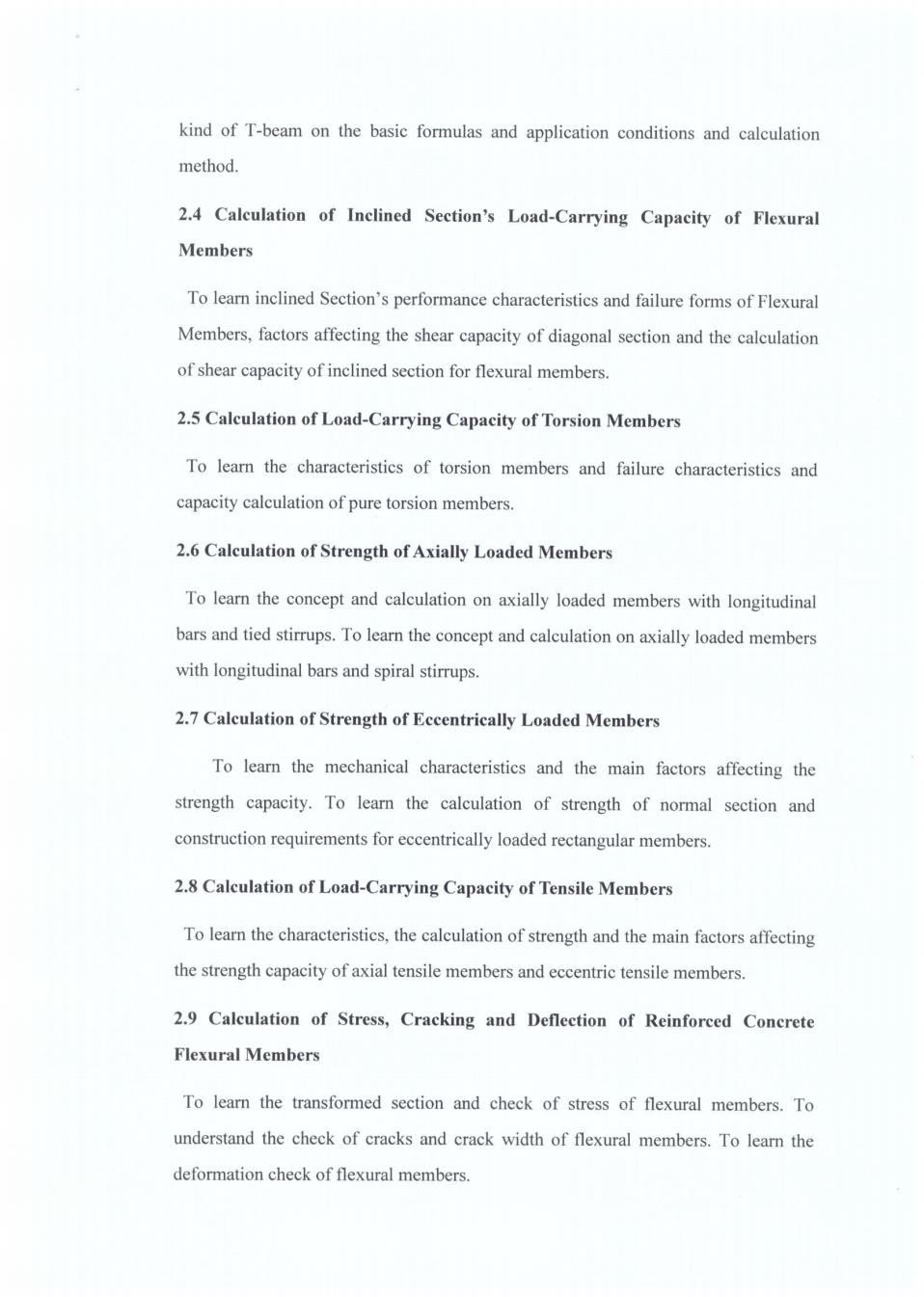
kind of T-beam on the basic formulas and application conditions and calculation method. 2.4 Caleulation of Inelined Section's Load-Carrying Capacity of Flexural Members To leam inclined Section's performance characteristics and failure forms of Flexural Members,factors affecting the shear capacity of diagonal section and the caleulation of shear capacity of inclined section for flexural members. 2.5 Calculation of Load-Carrying Capacity of Torsion Members To learn the characteristics of torsion members and failure characteristics and capacity calculation of pure torsion members. 2.6 Calculation of Strength of Axially Loaded Members To learn the concept and calculation on axially loaded members with longitudinal bars and tied stirrups.To learn the concept and calculation on axially loaded members with longitudinal bars and spiral stirrups. 2.7 Calculation of Strength of Eccentrically Loaded Members To learn the mechanical characteristics and the main factors affecting the strength capacity.To learn the calculation of strength of normal section and construction requirements for eccentrically loaded rectangular members 2.8 Calculation of Load-Carrying Capacity of Tensile Members To learn the characteristics,the calculation of strength and the main factors affecting the strength capacity of axial tensile members and eccentric tensile members. 2.9 Calculation of Stress,Cracking and Deflection of Reinforced Conerete Flexural Members To learn the transformed section and check of stress of flexural members.To understand the check of cracks and crack width of flexural members.To learn the deformation check of flexural members

2.10 Prestressed Concrete Structures To lear the basic concepts of prestressed concrete structures,partially prestressed concrete structures and unbonded prestressed concrete structures.To leamn the methods and equipment for prestressing construction and materials of prestressed concrete structures. 2.11 Brick Masonry Structures and Concrete Struetures To learn the basic concepts,engineering applications and capacity calculation of masonry structures. 3.Teaching links and time allocation Teaching link description:this course is 32 classes in total,teaching steps include the elassroom teaching and extracurricular counseling,homework interpretation,ete other time allocation recommendations are shown in table Total Mid term Teaching content Lecture hours Experimental Computer Other Pandect.Chapter 4 Chapter 2 ) Chapter3 6 Chapter 4 4 Chapter 5 1 Chapter6 Chapter7 Chapter 8 Chapter 9 2 2 0 0 Chapter 11 Chapter 12 Chapter 13 2 3 0 Chapter 15 Chapter 16 Chapter 17 0 0 Total 32
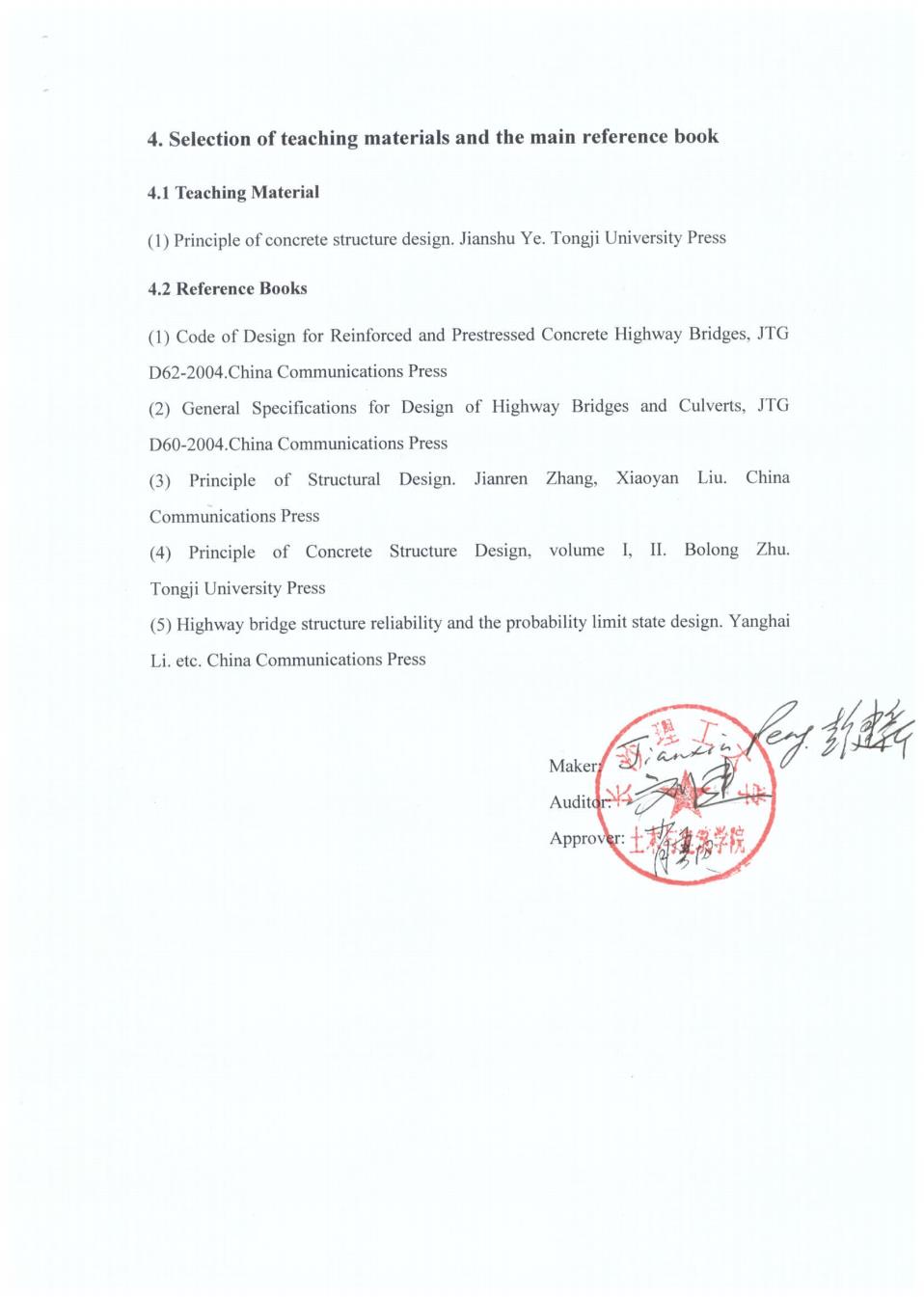
4.Selection of teaching materials and the main reference book 4.1 Teaching Material (1)Principle of concrete structure design.Jianshu Ye.Tongji University Pres 4.2 Reference Books (1)Code of Design for Reinforced and Prestressed Concrete Highway Bridges,JTG D62-2004.China Communications Press (2)General Specifications for Design of Highway Bridges and Culverts,JTG D60-2004.China Communications Press (3)Principle of Structural Design.Jianren Zhang.Xiaoyan Liu.China Communications Press (4)Principle of Concrete Structure Design,volume I,II.Bolong Zhu. Tongji University Press (5)Highway bridge structure reliability and the probability limit state design.Yanghai Li.ete.China Communications Press Make Audit Appo心土学